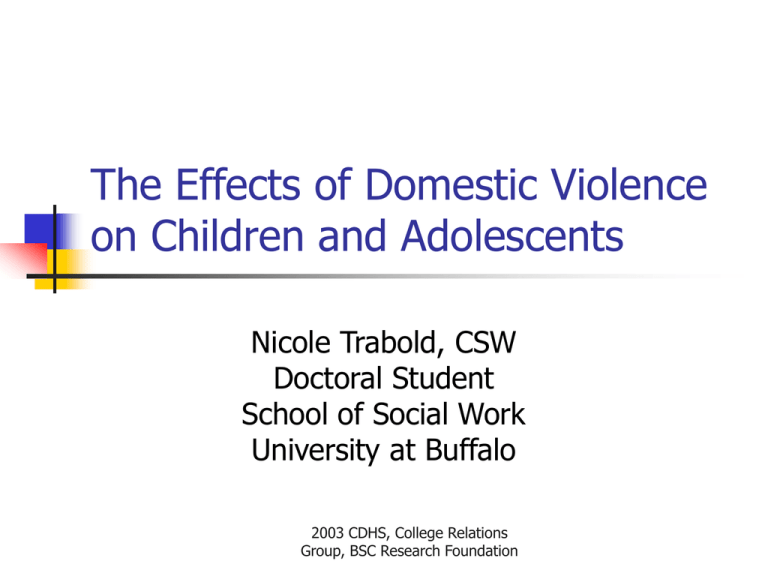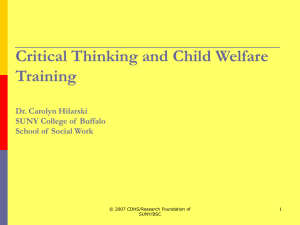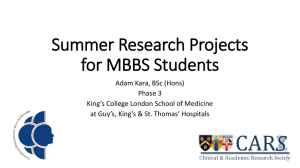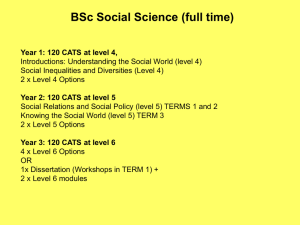
The Effects of Domestic Violence
on Children and Adolescents
Nicole Trabold, CSW
Doctoral Student
School of Social Work
University at Buffalo
2003 CDHS, College Relations
Group, BSC Research Foundation
What is Domestic Violence
Frequently referred to as:
“Battering”
“Spouse Abuse”
2003 CDHS, College Relations
Group, BSC Research Foundation
Commonly referred to today as Intimate
Partner Violence (IPV)
2003 CDHS, College Relations
Group, BSC Research Foundation
Definition
Is the violence committed by a spouse,
ex-spouse, or current or former partner
(heterosexual and homosexual
relationships)
All definitions per the Center for Disease
Control and Prevention (CDC), 2003
2003 CDHS, College Relations
Group, BSC Research Foundation
Motivation = Domination and Control
Strategy = Purposeful Coercion
Tactics = Selectively Chosen
Pattern = Episodic, Recurrent, Chronic
Impact = Injury, Fear, Pain, Isolation
American College of Obstetrics and Gynecology
2003 CDHS, College Relations
Group, BSC Research Foundation
Four Categories of Violence
Physical
Sexual
Threats of Physical or Sexual Harm
Psychological/Emotional
2003 CDHS, College Relations
Group, BSC Research Foundation
Physical Violence
The intentional use of physical force with the
potential to cause death, disability, injury, or
harm
Pushing
Punching
Biting
Slapping
Kicking
Choking
Use of a Weapon
2003 CDHS, College Relations
Group, BSC Research Foundation
Sexual Violence
The use of physical force to compel a
person to engage in a sexual act
against their will
Attempted or completed sex act
involving a person that is unable to
consent
Abusive sexual contact
2003 CDHS, College Relations
Group, BSC Research Foundation
Threat of Physical or Sexual
Violence
Use of words, gestures or weapons to
communicate the intent to cause:
Death
Disability
Injury
Physical Harm
2003 CDHS, College Relations
Group, BSC Research Foundation
Psychological/Emotional Abuse
Trauma to a victim caused by acts or threats
of acts, or coercive tactics such as:
Humiliating the victim
Controlling the victim
Destroying property
Using the children to control the victims behavior
Withholding money and/or transportation
Isolation from friends and family
2003 CDHS, College Relations
Group, BSC Research Foundation
Fighting vs. Abuse
Arguments, disagreements, and differences of
opinion are part of a ‘normal’ relationship.
What distinguishes an abusive relationship is
the ongoing pattern of disproportionate
control and coercion
Abuse is not a ‘fight’ between people of equal
power, but occurs where there is an
imbalance of power and control tactics are
used
2003 CDHS, College Relations
Group, BSC Research Foundation
2003 CDHS, College Relations
Group, BSC Research Foundation
2003 CDHS, College Relations
Group, BSC Research Foundation
Theoretical Frameworks
Social Cognitive Theory (Bandura)
Emphasis on observational learning
Violence was modeled and emphasized
Those that love you hit you
Those you love are people who can hit you
Feminist Theory
Violence is the result of a patriarchal social
system that gives men responsibility for
control over their female partners
2003 CDHS, College Relations
Group, BSC Research Foundation
Social Exchange Theory
Interaction is guided by a cost – reward
analysis
Ecological Theory
This recognizes that no one theory can
predict IPV
2003 CDHS, College Relations
Group, BSC Research Foundation
Intimate Partner Violence and
Child Abuse/Maltreatment
A study conducted in a Massachusetts D.S.S
found after a record review of suspected or
confirmed child maltreatment cases that 32%
also documented IPV - Hagen, 1994
A study by Stark and Flitcraft, 1998 found
after reviewing the medical records of
mothers whose children were seen in a
hospital setting and were referred for child
maltreatment that 45% had a documented
history of IPV
2003 CDHS, College Relations
Group, BSC Research Foundation
40% of women who were seeking services at
a battered women’s shelter reported that
their spouse physically abused their childrenSuh & Abel, 1990
According to Two National Surveys 50-70% of
families with IPV also reported physical abuse
toward the child – Bowker et al., 1988; Stauss
& Gillis, 1990
2003 CDHS, College Relations
Group, BSC Research Foundation
In Summary…
Studies show that in approximately
50% of cases where women are victims
of violence, children are victims of
physical violence
Or… in 50% of cases of child physical
abuse, women are also victims of
physical violence
2003 CDHS, College Relations
Group, BSC Research Foundation
Intimate Partner Violence Harms
Children In Various Ways
Perpetrators of violence may physically
harm their intimate partner and their
children
They may sexually abuse their children
or the children of their intimate partner
The physical abuse prevents the victim
of violence from caring for the children
2003 CDHS, College Relations
Group, BSC Research Foundation
Harms Continued…
Children may be coerced by the
perpetrator to assist in the violence
against the victim
Children witness violence
Perpetrators of violence may undermine
interventions to protect children
2003 CDHS, College Relations
Group, BSC Research Foundation
So how do you ask about IPV?
First and foremost – INTERVIEW THE
WOMAN ALONE
Create a private space to conduct an
interview
Conduct the interview in the primary
language
2003 CDHS, College Relations
Group, BSC Research Foundation
How to ask…
Be direct and nonjudgmental
Have good eye contact
Stay calm
Do not exhibit emotionally charged
reactions
Do not dismiss what is being told to you
2003 CDHS, College Relations
Group, BSC Research Foundation
How do you start?
You may want to start in a general
manner…
“Because violence is so common in many
people’s lives, I’ve begun to ask all my
clients about it.”
“Many women I see are dealing will
violence in their relationships. Some are
too afraid to bring it up themselves, so I
have begun to ask about it routinely.”
2003 CDHS, College Relations
Group, BSC Research Foundation
Specific Screening Questions
Are you in a relationship in which you have
been physically hurt or threatened by your
partner?
Has your partner ever destroyed things you
cared about?
Has your partner ever forced you to have sex,
or engage in sex that makes you feel
uncomfortable?
Do you feel afraid of your partner?
2003 CDHS, College Relations
Group, BSC Research Foundation
More Screening Questions…
Has your partner ever prevented you from
leaving the house, visiting family, seeking
friends, getting a job, or going to school?
Has your partner threatened or harmed your
children in any way?
Do you have guns in your home? Has your
partner threatened to use them?
Questions from the American Medical Association
Practice Guidelines for Screening for IPV
2003 CDHS, College Relations
Group, BSC Research Foundation
Or Sometimes You Need To
Ask…
Did someone cause this injury? (or
insert black eye, broken wrist etc.)
2003 CDHS, College Relations
Group, BSC Research Foundation
Do You Screen in Front of
Children?
If the child is 3 or younger it may be fine
However it is best to take the lead from the
mother… so ask
Some factors to consider why not to have
children present:
Women fear the children will accidentally disclose
Fear of traumatizing the child by listening
Need to protect the abuser
Concern that the child would worry and want to
protect
Zink and Jacobson 2003
2003 CDHS, College Relations
Group, BSC Research Foundation
What Next When The IPV
Screen is Positive?
Safety Plan, Safety Plan, Safety Plan
2003 CDHS, College Relations
Group, BSC Research Foundation
What is a Safety Plan?
A tool to assist in identifying options,
evaluating those options and
committing a plan to reduce the risk
when confronted with threat of harm or
with actual harm
2003 CDHS, College Relations
Group, BSC Research Foundation
Developing a Safety Plan
When your partner escalates where can
you move that is low risk
**avoid the kitchen, garage, or rooms
where there are weapons **
Use your judgment or intuition – if the
situation is very serious what can be
done to calm your partner
2003 CDHS, College Relations
Group, BSC Research Foundation
Safety Planning Continued…
Where can you leave money, important
documents and cloths (i.e. with someone or
have a bag packed and hidden)
Can you create a code word or signal with a
friend or neighbor that indicates the need for
help
Is there a safe place to go - Is it appropriate
to have a plan of escape
2003 CDHS, College Relations
Group, BSC Research Foundation
Safety Planning…
Do they have an Order of Protection
Is it with them at all times
Are copies provided to those who need it
(hospital, local police departments, friends
or family, employer, children’s day care)
What will you do if your partner violates
the order
2003 CDHS, College Relations
Group, BSC Research Foundation
Safety Planning…
Provide community resources in a
manner that is safe from the partner
2003 CDHS, College Relations
Group, BSC Research Foundation
How Does Witnessing IPV
Affect Children?
Children’s Problems Associated with
Witnessing Violence have been
categorized as:
Behavioral and Emotional
Cognitive Functioning and Attitude
Longer Term
2003 CDHS, College Relations
Group, BSC Research Foundation
Children who witness parental IPV may
exhibit
aggression
hostility
anxiety
social withdrawal
cognitive-functioning problems
depression
lower-verbal and quantitative skills
attitudes supporting violence
(Edleson 1999)
2003 CDHS, College Relations
Group, BSC Research Foundation
Impact of Exposure to
Domestic Violence
Increase in Externalizing Behaviors
Aggressiveness
Behavior problems in school
Temper Tantrums
Fights
2003 CDHS, College Relations
Group, BSC Research Foundation
Increase in Internalizing Behaviors
Depression
Suicidal Behavior
Anxiety
Fear
Phobias
Insomnia
Bed-wetting
Low Self-Esteem
2003 CDHS, College Relations
Group, BSC Research Foundation
Cognitive and Academic Functioning
Problems
Impaired ability to concentrate
Difficulty with school work
Lower scores in verbal, motor and
cognitive measures
2003 CDHS, College Relations
Group, BSC Research Foundation
Witnessing IPV and Post
Traumatic Stress Disorder (PTSD)
Study by Kilpatrick, Litt and Williams
(1997) showed that 85% of children
ages 6-12 who witnessed IPV had
moderate to severe PTSD symptoms
Compared to 0% of the control group
who had witnessed no violence
2003 CDHS, College Relations
Group, BSC Research Foundation
PTSD Symptoms May Be
Emotional Numbing
Increased Arousal
Avoidance of Reminders of the Violent
Event
Obsessive or Repeated Focus on the
Event
2003 CDHS, College Relations
Group, BSC Research Foundation
Long Term Implications
Retrospective studies have shown that
negative effects of IPV persist into
adulthood with increased rates of
Depression
Poor Self-Esteem
Violent Practices in the Home
Criminal Behavior
Fantuzzo and Mohr 1999
2003 CDHS, College Relations
Group, BSC Research Foundation
Impacts of Violence on Child
Development
Infancy
Insecure attachment
2003 CDHS, College Relations
Group, BSC Research Foundation
Toddlers
Hesitancy to explore
Separation Anxiety
Aggression
Withdrawal
Reduced ability to cope with frustrations
Communication problems
2003 CDHS, College Relations
Group, BSC Research Foundation
Preschoolers
Disrupted Interpersonal Relationships
Cognitive Difficulties
Lack in peer support
Caretaking by child
2003 CDHS, College Relations
Group, BSC Research Foundation
School-age and Adolescents
Aggression, Delinquency
Self-Destructive Behaviors
Bias for interpreting hostile intent
Limited competent social responses
Depression, Anxiety, Fear
Post-Traumatic Stress Symptoms
Hypervigilance, Hyperarousal
2003 CDHS, College Relations
Group, BSC Research Foundation
Disruptions at one stage my contribute
to the next stage further disrupting the
mastery of the following developmental
stages
2003 CDHS, College Relations
Group, BSC Research Foundation
How do you Respond to
Children?
Believe Them
2003 CDHS, College Relations
Group, BSC Research Foundation
Allow children the opportunity to tell
their story
Start with what they know and think
You can ask neutral questions to facilitate
the process for them only if you see they
are willing to share
Do NOT ask further questions if the child
appears uncomfortable or unwilling to
continue the discussion
2003 CDHS, College Relations
Group, BSC Research Foundation
Reflect Back on and Validate Their
Feelings
That must have been scary for you
2003 CDHS, College Relations
Group, BSC Research Foundation
Provide Reassurance - Children Need to
Know That Adults are Available to Help
You may respond by saying:
It is not their fault
Violence is NOT ok
You do not deserve to have violence in your
family
2003 CDHS, College Relations
Group, BSC Research Foundation
What Helps Children Exposed
to Violence?
Help Children Identify Safe People
Having a powerful relationship with an
adult is important in healing from trauma
Children need to have an adult that
believes in them
2003 CDHS, College Relations
Group, BSC Research Foundation
Provide Nurturing, Time and Attention
Provide Structure and Consistency
Humor
Creativity
Involvement with Activities
2003 CDHS, College Relations
Group, BSC Research Foundation
Interventions for Children
Exposed to Violence
Help to Re-Establish a Safe Environment
Identify the Non-Offending Parent and
Provide Information, Resources,
Support and Advocacy
2003 CDHS, College Relations
Group, BSC Research Foundation
Assess the Child, Family Living Situation
and Events Child Has Been Exposed to
2003 CDHS, College Relations
Group, BSC Research Foundation
Recommendations Will Depend on
Child’s age
Stage of development
Nature and duration of symptoms
Child’s functioning
Child’s perception of and experiences with
the violence
2003 CDHS, College Relations
Group, BSC Research Foundation
Current Environment
Presence of adults for emotional support
Cultural and ethnic definitions of violence
2003 CDHS, College Relations
Group, BSC Research Foundation
Therapeutic Interventions are Many
Times Appropriate
Group
Individual
2003 CDHS, College Relations
Group, BSC Research Foundation
Group Interventions
Generally Target ages 5-15
Less Helpful to Preschoolers
Not Appropriate for More Traumatized
Children
Not Appropriate to Children with More
Complex Needs
Provide Assistance with Developmental
Tasks
2003 CDHS, College Relations
Group, BSC Research Foundation
Four Major Goals of Groups
Break the Family Secret
Defining violence
Sharing personal experience
Learning about feelings
2003 CDHS, College Relations
Group, BSC Research Foundation
Learning to Protect
Assertive conflict resolution
Safe/Unsafe touching
2003 CDHS, College Relations
Group, BSC Research Foundation
Positive Experiences in a Safe
Environment
Strengthening Self-Esteem by Positive
Reinforcement
Peled and Davis 1995
2003 CDHS, College Relations
Group, BSC Research Foundation
Individual
More Appropriate for Younger Children
Children Who are More Impulsive
Have Fewer Peer-Relationships
This Intervention Promotes Discussion
Helps Children Understand and Cope
with their Feelings
Helps Reduce Symptoms (i.e. insomnia,
nightmares)
2003 CDHS, College Relations
Group, BSC Research Foundation
Interventions that Help Children
Involve a Range of Disciplines
Collaborate, Collaborate, Collaborate
2003 CDHS, College Relations
Group, BSC Research Foundation
So What Happens Now?
What Does this Mean When you are
Confronted with IPV in the Field?
2003 CDHS, College Relations
Group, BSC Research Foundation
Guiding Framework for
Interventions
Recommendation 1
To achieve three outcomes
Create Safety
Enhance Well-Being
Provide Stability for Children and Families
All recommendations adapted from Effective
Interventions In Domestic Violence and Child
Maltreatment Cases: Guidelines for Policy and Practice
2003 CDHS, College Relations
Group, BSC Research Foundation
Recommendation 2
Creating safety for the adult victim and
stopping batterer assaults removes risk
and creates permanency for the child
2003 CDHS, College Relations
Group, BSC Research Foundation
How Do You Create Safety?
Service Planning With a Focus on:
Securing Safe Housing
Advocacy Services
Help Secure Financial Income
Emotional Support for Adult Victim &
Children
Legal Assistance for Custody and/or Orders
of Protection
2003 CDHS, College Relations
Group, BSC Research Foundation
Recommendation 3
Make Every Effort to Develop Separate
Service Plans for the Adult Victims and the
Perpetrator of Violence Regardless of Their
Legal Status
2003 CDHS, College Relations
Group, BSC Research Foundation
Perpetrators Are Often Left Out Because
They May Not Be
Living in the Home
Legally or Biologically Related to the Child
Inconsistent Presence in the Family
Make Workers Feel Unsafe
2003 CDHS, College Relations
Group, BSC Research Foundation
Service Plans For Perpetrators
Should Include…
Cessations of All Forms of Violence to
all Members of the Family
Cessation of Interference with Partner’s
Efforts to Parent Safely
Compliance With Protective Orders and
Other Court Mandates
Compliance With Batterers Programs
2003 CDHS, College Relations
Group, BSC Research Foundation
Recommendation 4
Keep the child with the non-offending
parent whenever possible
2003 CDHS, College Relations
Group, BSC Research Foundation
Remember…
To Avoid Blaming the Non-Abusive
Parent for “Failure to Protect” Against
the Violence Committed by the Batterer
2003 CDHS, College Relations
Group, BSC Research Foundation
People Frequently Ask Why Do
Victims Stay?
Victims of Violence Calculate the Risks and
Benefits of Their Decisions
They May Ask Themselves
“Will the violence escalate if I leave?”
“How will I support myself and children?”
“Where will we live, will it be safe for my
children?”
“Should I leave and risk losing my children in a
custody battle to the abusive parent?”
2003 CDHS, College Relations
Group, BSC Research Foundation
Recommendation 5
Avoid using or use cautiously interventions
such as:
Couples Therapy
Mediation
Family Conferencing
Anger Management Classes
2003 CDHS, College Relations
Group, BSC Research Foundation
Recommendation 6
Pay careful attention to visitation
arrangements that may endanger adult
victims and their children
2003 CDHS, College Relations
Group, BSC Research Foundation
Points to Assess
Perpetrators History of Abuse and
Neglect to Children
Level of Continued Danger to the Adult
Victim of IPV
History and Pattern of Abuse
History of Using Children In Violence or
Exposing them to Violence
2003 CDHS, College Relations
Group, BSC Research Foundation
Level of Coercive Control Exhibited by The
Perpetrator of Violence
History of Substance Abuse and Mental
Illness
Perpetrators Willingness to Accept Decisions
From Victim, Law Enforcement etc.
Risk of Child Abduction
Bancroft and Silverman 2002
2003 CDHS, College Relations
Group, BSC Research Foundation
Recommendation 7
If a child needs to be placed in foster care,
with a relative or with an adoptive family
assessments prior to placement should
Determine Ability to Keep Child Safe
Ensure Safety During Visitation
Determine that Caregiver is Supportive of the
Adult Victim of Violence
2003 CDHS, College Relations
Group, BSC Research Foundation
When Evaluating If a Placement is
Appropriate
2003 CDHS, College Relations
Group, BSC Research Foundation
Assessing The Risk to Children
Detailed Review of the Trauma
Current Symptoms
Developmental History
Reactions of Adult Victim and
Perpetrator on the Childs Experience
and Symptoms
Groves, Roberts and Weinreb 2000
2003 CDHS, College Relations
Group, BSC Research Foundation
Assess For Safety
Does the Adult Victim of Violence
Perceive Themselves or Their Children
to be Safe
2003 CDHS, College Relations
Group, BSC Research Foundation
Parenting
Adequacy of Victim and Perpetrator
Parenting in the Context of IPV
2003 CDHS, College Relations
Group, BSC Research Foundation
Risk of Continued Exposure to
the Perpetrator
Risk of continued undermining of Adult
Victim Parenting and Relationship with
Non-Abusive Parent
Continued Exposure to Authoritative or
Neglectful Parenting
2003 CDHS, College Relations
Group, BSC Research Foundation
Risk of Continued Exposure to Violence
Risk of Learning Violent Behaviors
Risk of Being a “Tool” for the
Perpetrator
Bancroft and Silverman 2002
2003 CDHS, College Relations
Group, BSC Research Foundation
Nicholson v. Williams
Class Action Court Case
‘Battered’ Women and Their Children
Challenged New York City’s Child
Welfare Policies Regarding Cases that
Involve IPV
2003 CDHS, College Relations
Group, BSC Research Foundation
The Court Findings
The Child Welfare Agency Regularly
Alleges and Indicates Neglect Against
Battered Mothers
The Child Welfare Agency Rarely Hold
Batterers Accountable
The Child Welfare Agency Failed to
Offer Adequate Resources Before
Removal
2003 CDHS, College Relations
Group, BSC Research Foundation
The Child Welfare Agency Regularly
Separates Battered Women From Their
Children Unnecessarily
2003 CDHS, College Relations
Group, BSC Research Foundation
The Court Issued an
Injunction
The Child Welfare Agency May Not
Remove a Child on the Grounds that a
Mother is a Victim of IPV Unless There
is Imminent Danger to the Child
Reasonable Efforts Must be Made to
Remove the Batterer From the Mother
and Child Using All Possible Resources
2003 CDHS, College Relations
Group, BSC Research Foundation
Injunction Continued
Complaints Against ‘Battered’ Mothers
to the Central Registry Shall Be
Declared “Unfounded” if the Only
Reason for Services Was IPV Related
Court Information Adapted from Jill M.
Zuccardy, Esq. Sanctuary for Families’ Center
for Battered Women’s Legal Services
2003 CDHS, College Relations
Group, BSC Research Foundation
Resources Everyone Should
Know
New York State Adult Domestic Violence
Hotline
English 1-800-942-6906
Spanish 1-800-942-6908
2003 CDHS, College Relations
Group, BSC Research Foundation
National Resource Center on Domestic
Violence
1-800-537-2238
Violence Against Women’s Act National
Hotline
1-800-799-SAFE
2003 CDHS, College Relations
Group, BSC Research Foundation








